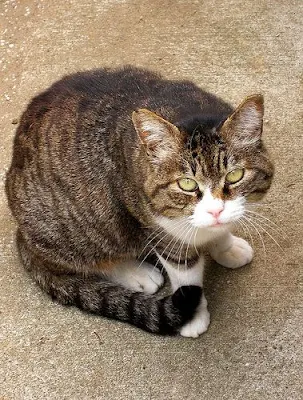
Tabby cat with white - Photograph copyright tanakawho (see below)
A tabby cat breed is a breed of cat that a considerable number of people think exists but does not. It is easy to get into this mode of thinking as we hear about tabby cats a lot. We hear about them in the same way that we hear about genuine cat breeds.
A tabby cat is a cat with a certain type of coat. In fact it is the most common type of coat. It is a coat that has it's origins in wild cats and is clearly seen in wild cats such as the Scottish Wildcat and the American Bobcat. The Egyptian Mau an exotic looking naturally spotted cat and a tabby cat is thought to be a domesticated African wild cat, which of course is also a tabby cat.
The tabby coat is the most natural looking coat and provides the best protection in terms of being camouflage. It also can produce an appearance that is does not look like camouflage at all but is in fact well suited to forest light. I am talking about the Tiger. There is also perhaps the fact that this big wildcat is so dominant that he or she does not need to be camouflaged in the same way as the smaller wildcats.
Some cat breeders are doing their best to replicate the ubiquitous but remarkable markings of the Tiger in a domestic cat called the Toyger (toy Tiger). The Toyger's appearance is based around the tabby mackerel coat but very refined and carefully bred to resemble the Tiger. The Toyger is a designer cat and very distinctive. If there was a tabby cat breed this cat would be at the top of the list of examples, perhaps.
Update: There is another post on the tabby coat with some of Helmi Flick's pictures of tabby cats. I also discuss the genetics behind the tabby look in this post. The linked post is actually very comprehensive and I would recommend a look as it covers genetics and the various types of tabby cat coats.
In the domestic cat there are several types of tabby coat patterns including Abyssinian (ticking), mackerel (stripped), mackerel spotted (Bengal arrow head or rosettes for example) and blotched (Bengal marbled pattern).

Mackerel Tabby -- cat a fine mixed breed cat photo copyright Helmi Flick
Cat coat genetics are not only extremely complicated but as as far as I am aware are still being researched. Often there is an interplay between various genes to produce a coat that on first sight cannot be pigeon holed into a cat coat category. An example might be lynx pointed cats. You wouldn't have thought the tabby pattern could be found in a pointed cat. We think of Siamese cats as pointed cats and cannot initially see a connection between the tabby pattern and color points. But cat breeders have developed various types of points and one is a pointed pattern where the dark extremities are broken by the gene that produces the tabby pattern. You can see a lynx pointed cat in this post.
The tabby pattern is cuts across cat breeds and is found most commonly in cats of mixed ancestry (mixed breed cats or Moggies). In fact, not only does this coat pattern cut across breeds it is found equally in domestic and wild cats. The tabby coat is seen is so many different cat breeds that it would be impossible to consider a tabby cat breed in any event.
The classic brown tabby is well known and looks not dissimilar to the Scottish Wildcat referred to above. This is to be expected as the domestic cat's origins are in the wildcats.
The splendid Maine Coon often has a tabby coat. A TICA champion Maine Coon of great distinction has a tabby pattern. The beautiful and wonderful looking Maine Coon cat called Daisy at the top of this page also has a tabby patterned coat. Daisy lives with Dani Rozeboom who photographed Daisy. Dani is a fine cat photographer.
Photograph at top of this page on tabby cat breed: This is a tabby and white cat photographed by a well known and talented photographer who publishes his photographs on Flickr called tanakawho. We know about you now.
Tabby Cat Breed to Maine Coon cats.



We have a Tabby Cat and were wondering what range of outdoor temperatures they can handle, without jeopardizing their health?
ReplyDeleteThank you for any help you may provide.
sincerely,
Craig N.
Hi, thanks for the comment. Domestic cats are excellent in cold weather. Think of the Maine Coon, the all American cat that came from being a barn cat (outdoor cat) to their current elevated status. Their usually double coat (some have single coats) provide excellent protection. But, being domesticated they have gotten used to indoor warmth and cats like warmth anyway. So, although they can cope with cold they shouldn't in my view be forced out into it. If given a choice (cat flap to outdoor enclosure for example) then they will go out into the cold quite happily for a while.
ReplyDeleteExtreme cold is another thing though in my opinion. Say minus centigrade temperatures (e.g. -5 to -20) is too cold and protection should be given. I don't think any domestic cat should be forced out or put out in the old fashioned way. They should have the choice, that is the domestication agreement.